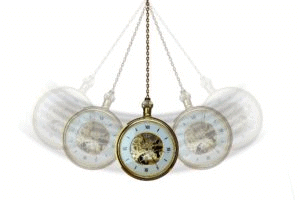Periodic & Oscillatory Motion | Physics for Airmen Group X - Airforce X Y / Indian Navy SSR PDF Download
Periodic Motion
What is common in the motion of the hands of a clock, wheels of a car and planets around the sun? They all are repetitive in nature, that is, they repeat their motion after equal intervals of time. A motion which repeats itself in equal intervals of time is periodic.
A body starts from its equilibrium position(at rest) and completes a set of movements after which it will return to its equilibrium position. This set of movements repeats itself in equal intervals of time to perform the periodic motion.
Circular motion is an example of periodic motion. Very often the equilibrium position of the object is in the path itself. When the object is at this point, no external force is acting on it. Therefore, if it is left at rest, it remains at rest.
Period and Frequency of Periodic Motion
We know that motion which repeats itself after equal intervals of time is periodic motion. The time period(T) of periodic motion is the time interval after which the motion repeats itself. Its S.I.unit is second.
The reciprocal of T gives the number of repetitions per unit time. This quantity is the frequency of periodic motion. The symbol υ represents frequency. Therefore, the relation between υ and T is
υ = 1/T
Thus, the unit of υ is s-1 or hertz(after the scientist Heinrich Rudolf Hertz). Its abbreviation is Hz. Thus, 1 hertz = 1 Hz = 1 oscillation per second = 1 s-1 The frequency of periodic motion may not be an integer. But it can be a fraction.
Oscillatory Motion

Oscillatory motion is the repeated to and fro movement of a system from its equilibrium position. Every system at rest is in its equilibrium position. At this point, no external force is acting on it. Therefore, the net force acting on the system is zero. Now, if this system is displaced a little from its fixed point, a force acts on the system which tries to bring back the system to its fixed point. This force is the restoring force and it gives rise to oscillations or vibrations.
For example, consider a ball that is placed in a bowl. It will be in its equilibrium position. If displaced a little from this point, it will oscillate in the bowl. Therefore, every oscillatory motion is periodic but all periodic motions are not oscillatory. For instance, the circular motion is a periodic motion but not oscillatory.
Moreover, there is no significant difference between oscillations and vibrations. In general, when the frequency is low, we call it oscillatory motion and when the frequency is high, we call it vibrations. Furthermore, simple harmonic motion is the simplest type of oscillatory motion. This motion takes place when the restoring force acting on the system is directly proportional to its displacement from its equilibrium position.
In practice, oscillatory motion eventually comes to rest due to damping or frictional forces. However, we can force them by means of some external forces. Also, a number of oscillatory motions together form waves like electromagnetic waves.
Displacement in Oscillatory Motion
Displacement of a particle is a change in its position vector. In an oscillatory motion, displacement simply means a change in any physical property with time.
Consider a block attached to a spring, which in turn is fixed to a rigid wall. We measure the displacement of the block from its equilibrium position. In an oscillatory motion, we can represent the displacement by a mathematical function of time. One of the simplest periodic functions is given by,
f(t) = Acosωt
If the argument, ωt, is increased by an integral multiple of 2π radians, the value of the function remains the same. Therefore, it is periodic in nature and its period T is given by,
T = 2π/ω
Thus, the function f(t) is periodic with period T. ∴ f(t) = f(t + T). Now, if we consider a sine function, the result will be the same. Further, taking a linear combination of sine and cosine functions is also a periodic function with period T.
f(t) = Asinωt + Bcosωt
Taking A = Dcos∅ and B = Dsin∅ equation V becomes, f(t) = Dsin(ωt + ∅). In this equation D and ∅ are constant and they are given by,
D = √A2 + B2 and ∅ = tan-2(B/A)
Therefore, we can express any periodic function as a superposition of sine and cosine functions of different time periods with suitable coefficients. The period of the function is 2π/ω.
Difference Between Periodic and Oscillatory Motion
The main difference is that oscillatory motion is always periodic but a periodic motion may or may not be oscillatory. For example, the motion of a pendulum is both oscillatory and periodic but the motion of the wheels of a car is only periodic because the wheels rotate in a circular motion. Thus, circular motion is only periodic and not oscillatory because the wheels do not move to and fro about a mean position.
|
201 videos|410 docs|280 tests
|
















